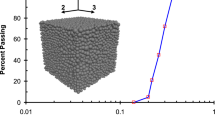Abstract
Continuum fracture mechanics concepts should be applied to solve dynamic fracture problems wherever a continuum approach can provide sufficient answers. Many dynamic fracture problems, however, involve multiple cracks or voids and are not well-suited to the relatively simple continuum approach. This paper describes a statistical fracture mechanics concept on a microscopi scale and illustrates its use for the case of shock-wave-induced ductile spall fracture. The paper further shows how micro-statistical fracture mechanics (MSFM) merges with continuum fracture mechanics by treating a macrocrack propagating in a DCB specimen using MSFM and the MSFM parameters deduced from the spall work.
Thus, the two approaches are consistent. Although significantly more complicated, the MSFM approach promises to be helpful in improving our understanding of the influences of microstructure on toughness and in extending continuum approaches to more ductile materials and to smaller specimens.
Résumé
Les concepts de fracture mécanique d'un continuum devraient être appliqués à la solution des problèmes de fracture de rupture dynamique dès lors qu'une approche par continuum peut fournir des réponses suffisantes. Cependant, plusieurs problèmes de rupture dynamique comportent des fissures ou des cavités multiples et ne sont pas bien adaptés à une approche par continuum relativement simple. Le mémoire décrit un concept de mécanique de la rupture statistique à une échelle microscopique et illustre son utilisation au cas d'une rupture par décollement ductile sous l'effet d'une onde de choc. On montre en outre qu'une mécanique de rupture micro-statistique peut être envisagée dans le mécanisme de rupture d'un continuum en traitant la propagation d'une macro-fissure dans une éprouvette Cantilever et en utilisant ce concept et les paramètres qui y sont liés, déduits du travail relatif à l'écaillage.
Ainsi, les deux approches se révèlent applicables. Bien que considérablement compliquées, l'approche de mécanique de rupture micro-statistique se révèle prometteuse pour améliorer notre compréhension des influences de la microstructure sur la ténacité et pour une extension de l'approche du continuum de milieu continu à des matériaux plus ductiles ou à des éprouvettes plus petites.
Similar content being viewed by others
References
L. Seaman, and D.A. Shockey, Models for Ductile and Brittle Fracture for Two-Dimensional Wave Propagation Calculations, Final Technical Report AMMRC CTR 75–2, Army Materials and Mechanics Research Center, Watertown, Massachusetts (1975).
L. Seaman, D.R. Curran and D.A. Shockey, Material Behavior Under High Stress and Ultrahigh Loading Rates, 29th Sagamore Army,Materials Research Conference, Plenum Press, New York (1983) 295.
D.A. Shockey, M. Austin, L. Seaman and D.R. Curran, Computation of Crack Propagation and Arrest by Simulating Microfracturing at the Crack Tip, Final Technical Report to Electric Power Research Institute, Palo Alto, California, Contract RP499–1–1 (1976).
C.F. HickeyJr., Toughness Data for Monolithic High-Hardness Armor Steel, AMMRC FTR 72–3, Army Materials and Mechanics Research Center, Watertown, Massachusetts (July 1972).
L. Seaman, D.R. Curran and R.C. Crewdson, Journal of Applied Physics 49 (1978) 5221.
T.W. BarbeeJr., L. Seaman, R. Crewdson and D.R. Curran, Journal of Materials 7 (1972) 393–401.
D.A. Shockey, L. Seaman, K.C. Dao and D.R. Curran, Journal of Pressure Vessel Technology 102 (1980) 14–21.
T. Kobayashi and D.A. Shockey, in Synergism of Microstructure, Mechanisms, and Mechanics in Fracture, AIME Annual Meeting, Los Angeles, CA, Feb. 27–29, 1984, to appear.
G.T. Hahn, R.G. Hoagland, M.F. Kanninen and A.R. Rosenfield, Dynamic Crack Propagation, G.C. Sih, Ed., Noordhoff International Publishing, Leyden (1972) 649.
J.R.H. Otter, A.C. Cassell and R.E. Hobbs, in Proceedings of the Institute of Civil Engineering Paper No. 6986 (1967).
Author information
Authors and Affiliations
Rights and permissions
About this article
Cite this article
Shockey, D.A., Seaman, L. & Curran, D.R. The micro-statistical fracture mechanics approach to dynamic fracture problems. Int J Fract 27, 145–157 (1985). https://doi.org/10.1007/BF00017964
Received:
Accepted:
Issue Date:
DOI: https://doi.org/10.1007/BF00017964




